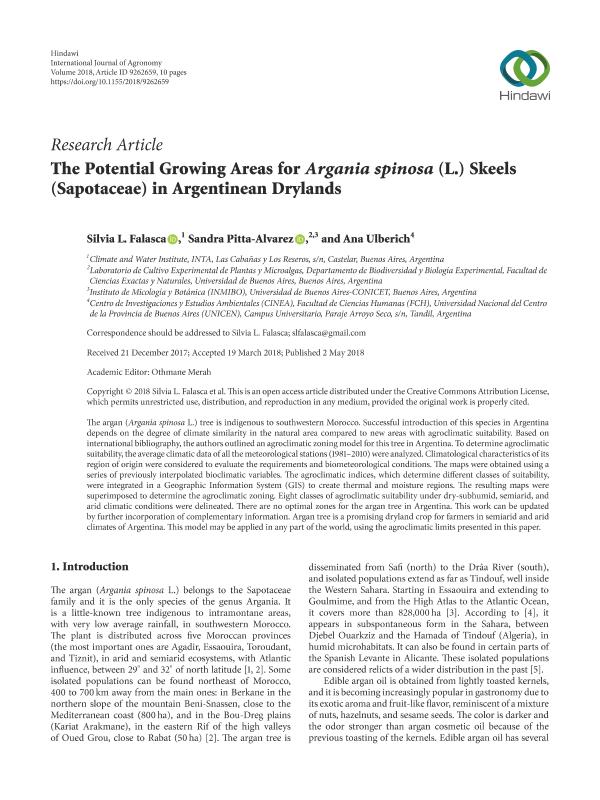Artículo
The Potential Growing Areas for Argania spinosa (L.) Skeels (Sapotaceae) in Argentinean Drylands
Fecha de publicación:
02/05/2018
Editorial:
Hindawi Publishing Corporation
Revista:
International Journal of Agronomy
ISSN:
1687-8159
e-ISSN:
1687-8167
Idioma:
Inglés
Tipo de recurso:
Artículo publicado
Clasificación temática:
Resumen
The argan (Argania spinosa L.) tree is indigenous to southwestern Morocco. Successful introduction of this species in Argentina depends on the degree of climate similarity in the natural area compared to new areas with agroclimatic suitability. Based on international bibliography, the authors outlined an agroclimatic zoning model for this tree in Argentina. To determine agroclimatic suitability, the average climatic data of all the meteorological stations (1981-2010) were analyzed. Climatological characteristics of its region of origin were considered to evaluate the requirements and biometeorological conditions. The maps were obtained using a series of previously interpolated bioclimatic variables. The agroclimatic indices, which determine different classes of suitability, were integrated in a Geographic Information System (GIS) to create thermal and moisture regions. The resulting maps were superimposed to determine the agroclimatic zoning. Eight classes of agroclimatic suitability under dry-subhumid, semiarid, and arid climatic conditions were delineated. There are no optimal zones for the argan tree in Argentina. This work can be updated by further incorporation of complementary information. Argan tree is a promising dryland crop for farmers in semiarid and arid climates of Argentina. This model may be applied in any part of the world, using the agroclimatic limits presented in this paper.
Palabras clave:
Argan
,
Agroclimatic Zoning
,
Geographic Information System
,
Dryland
Archivos asociados
Licencia
Identificadores
Colecciones
Articulos(INMIBO (EX - PROPLAME))
Articulos de INSTITUTO DE MICOLOGIA Y BOTANICA
Articulos de INSTITUTO DE MICOLOGIA Y BOTANICA
Citación
Falasca, Silvia Liliana; Pitta Alvarez, Sandra Irene; Ulberich, Ana Cristina; The Potential Growing Areas for Argania spinosa (L.) Skeels (Sapotaceae) in Argentinean Drylands; Hindawi Publishing Corporation; International Journal of Agronomy; 2018; 2-5-2018; 1-10; 9262659
Compartir
Altmétricas




